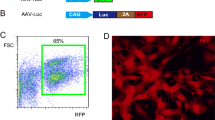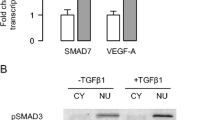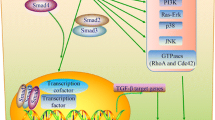Abstract
Pancreatic ductal adenocarcinoma (PDAC) is an extremely malignant tumor in humans. Thus, understanding the tumorigenesis of PDAC appears to help develop efficient therapy. Here, we show that activated TGFβ receptor signaling induces apoptosis of pancreatic carcinoma cells in vitro and in vivo, suggesting that activation of TGFβ receptor signaling may prevent development of PDAC.
Similar content being viewed by others
Avoid common mistakes on your manuscript.
Introduction
Pancreatic cancer is the fourth leading cancer killer in the USA. Overall, just 6 % of patients survive 5 years after diagnosis. In 2012, it is estimated that there will be 43,920 new diagnoses of pancreatic cancer and 37,390 attributed deaths [1, 2]. Pancreatic ductal adenocarcinoma (PDAC) is, by far, the most common type of pancreatic malignancy [1, 2]. PDAC caught at an early stage has a better chance of long-term survival, but the pancreas emits few known clues to signal that the carcinogenic process has begun; so, there are currently no early detection tests. For more than 30 years, NCI-supported laboratory scientists have been studying a gene called K-ras, the genetic driver of pancreatic cancer initiation and progression. However, at this time, no therapeutic solutions to K-ras mutations have been developed [1, 2]. Thus, further identifying risk factors and genetic changes, achieving greater understanding of the metastatic process, and developing better methods of early detection and treatment appear to be very critical for prevention of the occurrence of PDAC.
Transforming growth factor β (TGFβ) receptor signaling pathway is essential for various biological processes [3–5]. When a ligand binds to a type II TGFβ receptor, it catalyzes the phosphorylation of a type I TGFβ receptor, which triggers phosphorylation of intracellular proteins SMAD2 and SMAD3 to form heteromeric complexes with SMAD4. The activated SMAD complexes then translocate to the nucleus, where they regulate the transcription of target genes [3–7]. Previous studies have demonstrated that TGFβ receptor signaling plays a critical role in pancreas organogenesis [8] and in pathogenesis of pancreatitis and pancreatic ductal adenocarcinoma (PDAC) [9, 10]. However, an analysis of a direct effect of activated TGFβ receptor signaling on the PDAC is lacking.
Here, we show that activated TGFβ receptor signaling induces apoptosis of pancreatic carcinoma cells in vitro and in vivo, suggesting that activation of TGFβ receptor signaling may prevent the development of PDAC.
Materials and methods
Animals
All mouse experiments were performed in accordance with the guidelines from the Animal Research and Care Committee at the Chinese PLA General Hospital. K-ras-G12D mice [11, 12] and Ptf1a promoter Cre reporter (Ptf1a-Cre) mice [6, 13] were both purchased from the Jackson Lab (USA). Ptf1a-Cre mice were bred with K-ras-G12D mice to generate Ptf1a-Cre; K-ras-G12D mice. Only male mice of 20 weeks of age were used for experiments.
Intraductal infusion
Intraductal infusion was performed as has been previously described [14, 15]. Briefly, the duodenum was isolated to expose the common bile duct, after which a microclamp was placed on the common bile duct above the branching of the pancreatic duct. A 31-gauge blunt-ended catheter was then put into the common bile duct through the sphincter of Oddi in the duodenum, which was then clamped with another microclamp to prevent backflow. The other end of the catheter is connected to a micro-infusion apparatus, which delivers 100 μl of TGFβ1 with/without SB431542 via the catheter at a rate of 5 μl/min. After infusion, the hole created by the catheter in the duodenum was closed with 6–0 suture.
Cell line culture
PANC-1 was generated from a human carcinoma of the exocrine pancreas in 1975 [16], and was purchased from ATCC (USA). PANC-1 was cultured in Dulbecco’s modified Eagle’s medium (DMEM) supplemented with 20 % fetal bovine serum (Invitrogen, Carlsbad, CA, USA). Recombinant TGFβ1 and SB431542 were both purchased from Sigma (USA), and used both at a dosage of 10 μmol/l.
Apoptosis assay
Cells were labeled with annexin V-FITC and propidium iodide (PI), and then examined with an apoptosis detecting kit (Invitrogen, Canada) for apoptosis. Samples were analyzed by flow cytometry and the results were analyzed by CellQuest software (Becton Dickinson, San Jose, CA) as has been described before [17]. Terminal deoxynucleotidyl transferase-mediated dUTP-biotin nick end labeling (Tunel) staining was performed with an ApopTag® Peroxidase In Situ Apoptosis Detection Kit (Millipore, Billerica, MA, USA), according to the manufacturer’s instruction.
Immunohistochemistry
All the mice were perfused through the heart with phosphate-buffered saline (PBS) to remove blood cells from the circulation and to reduce non-specific immunostaining. Pancreata were subsequently fixed in 4 % formalin for 6 h, followed by cryo-protection in 30 % sucrose overnight before freezing in a longitudinal orientation (from tail to head of the pancreas) and sectioned at 6 μm. Primary antibody is rabbit anti-claudin18 (Santa Cruz, USA). Indirect fluorescent staining was performed with Cy3- or Cy2- conjugated donkey anti-rabbit secondary antibody (Jackson ImmunoResearch Labs, USA). TUNEL staining was performed as stated above. Nuclear staining was performed with 4ʹ,6-diamidino-2-phenylindole (DAPI; Cell signaling, USA). Quantification was done in five repeats in each condition and at least 1000 cells were counted in each number.
ELISA assay
The concentration of TGFβ1 was determined by a TGFβ1 ELISA Kit (R&D Systems, USA). ELISAs were performed according to the instructions of the manufacturer. Briefly, the collected condition media was added to a well coated with TGFβ1 polyclonal antibody, and then immunosorbent by biotinylated monoclonal anti-human TGFβ1 antibody at room temperature for 2 h. The color development catalyzed by horseradish peroxidase was terminated with 2.5 mol/l sulfuric acid and the absorption was measured at 450 nm. The protein concentration was determined by comparing the relative absorbance of the samples with the standards.
Western blot
The protein was extracted from the total pancreas, which were homogenized in RIPA lysis buffer (1 % NP40, 0.1 % sodium dodecyl sulfate (SDS), 100 μg/ml phenylmethylsulfonyl fluoride, 0.5 % sodium deoxycholate, in PBS) on ice. The supernatants were collected after centrifugation at 12,000×g at 4 °C for 20 min. Protein concentration was determined using a BCA protein assay kit (Bio-Rad, China), and whole lysates were mixed with 4X SDS loading buffer (125 mmol/l Tris–HCl, 4 % SDS, 20 % glycerol, 100 mmol/l DTT, and 0.2 % bromophenol blue) at a ratio of 1:3. Samples were heated at 100 °C for 5 min and were separated on SDS-polyacrylamide gels. The separated proteins were then transferred to a PVDF membrane. The membrane blots were first probed with a primary antibody. After incubation with horseradish peroxidase-conjugated second antibody, autoradiograms were prepared using the enhanced chemiluminescent system to visualize the protein antigen. The signals were recorded using x-ray film. Primary antibodies were anti-SMAD2 and anti-phosphorylated SMAD2 (pSMAD2) (Cell Signaling, USA).
Statistical analysis
All statistical analyses were carried out using the SPSS 17.0 statistical software package. All values are depicted as mean ± standard deviation and are considered significant if p < 0.05. All data were statistically analyzed using one-way ANOVA with a Bonferroni correction.
Results
Activated TGFβ receptor signaling induced PDAC cell apoptosis in vitro
TGFβ receptor signaling pathway plays a critical role in pancreas organogenesis [8] and in pathogenesis of pancreatitis and PDAC [9, 10]. Specifically, TGFβ receptor signaling has been shown of a paradoxical effect on tumorigenesis, which may largely result from its diverse effects on tumor cells and tumor periphery cells. Here, we focused on the effect of TGFβ receptor signaling pathway on the tumor cells themselves. We gave a human PDAC cell line PANC-1 a robust TGFβ receptor ligand, TGFβ1, at 10 μmol/l, to activate TGFβ receptor ligand. We found that TGFβ1 significantly increased the apoptosis of the PANC-1 cells, by 2ʹ,7ʹ–dichlorofluorescein diacetate (DCF-DA) assay (Fig. 1a), and by TUNEL assay (Fig. 1b, c). Moreover, the effect of TGFβ1 on apoptosis was completely inhibited by a TGFβ receptor I inhibitor, SB431542 (10 μmol/l) [7], which inhibited downstream signaling of TGFβ receptor activation (Fig. 1a–c). These data suggests that activated TGFβ receptor signaling induced PDAC cell apoptosis in vitro.
Activated TGFβ receptor signaling induced PDAC cell apoptosis in vitro. We gave a human PDAC cell line (PANC-1) 10 μmol/l TGFβ1 to activate TGFβ receptor. a–c We found that TGFβ1 significantly increased the apoptosis of the PANC-1 cells, by DCF-DA assay (a), and by TUNEL assay, shown by quantification (b) and by representative images (c). The effect of TGFβ1 on apoptosis was completely inhibited by a TGFβ receptor I inhibitor, SB431542 (10 μmol/l). *p < 0.05. DAPI nucleus staining, blue. Scale bar is 50 μm
Development of PDAC in Ptf1a-Cre; K-ras fx/fx mice
Then, we aimed to examine the effects of activated TGFβ receptor signaling on PDAC in vivo. We used an established mouse PDAC model (Ptf1a-Cre; K-ras-G12D) [18], and we confirmed PDAC development in these mice (Fig. 2).
In vivo activation of TGFβ receptor signaling induced PDAC cell apoptosis
Then, we examined the effect of activated TGFβ receptor signaling on PDAC in vivo. We used an intraduct infusion system to deliver TGFβ1 (100 μmol/l) in 100 μl volume to the pancreas of Ptf1a-Cre; K-ras-G12D mice, as has been previously described [14, 15]. SB431542 (100 μmol/l) was infused with TGFβ1 in a loss-of-function experiment. One day after infusion, the levels of TGFβ1 in the pancreas of Ptf1a-Cre; K-ras-G12D mice that received TGFβ1 infusion were quantified, showing significant increases in the levels of TGFβ1 (Fig. 3a). Infusion with both TGFβ1 and SB431542 did not alter the levels of TGFβ1 in the pancreas, but decreased the activity of TGFβ receptor signaling, which was confirmed by phosphorylation of SMAD2 (Fig. 3b). We found that in vivo activation of TGFβ receptor signaling induced PDAC cell apoptosis (Fig. 3c, d).
In vivo activation of TGFβ receptor signaling induced PDAC cell apoptosis. We used an intraductal infusion system to deliver TGFβ1 (100 μmol/l) in 100-μl volume to the pancreas of Ptf1a-Cre; K-ras-G12D mice. SB431542 (100 μmol/l) was infused with TGFβ1 in a loss-of-function experiment. a–b 1 day after infusion, the levels of TGFβ1 in the pancreas of Ptf1a-Cre; K-ras-G12D mice that received TGFβ1 infusion were quantified by ELISA (a), and SMAD2 and pSMAD2 were analyzed by Western blot (b). c PDAC cell apoptosis was quantified as TUNEL-positive Claudin-18-positive cells. *p < 0.05. NS non-significant. Claudin-18 staining, red. Scale bar is 50 μm
Discussion
PDAC is highly lethal. For more than 30 years, NCI-supported laboratory scientists have been studying a gene called K-ras, the genetic driver of pancreatic cancer initiation and progression [12]. However, at this time, no therapeutic solutions to K-ras mutations have been developed [1, 2]. Thus, further identifying risk factors and genetic changes, achieving greater understanding of the metastatic process, and developing better methods of early detection and treatment appear to be very critical for prevention of the occurrence of PDAC.
TGFβ receptor signaling pathway is essential for various biological processes [3–5]. Previous studies have demonstrated that TGFβ receptor signaling plays a critical role in pancreas organogenesis [8] and in pathogenesis of pancreatitis and PDAC [9, 10]. However, an analysis of a direct effect of activated TGFβ receptor signaling on the PDAC is lacking.
Here, we focused on the effect of TGFβ receptor signaling pathway on the tumor cells themselves. We treated a human PDAC cell line PANC-1 with TGFβ1 to activate TGFβ receptor signaling. To specifically inhibit the TGFβ1-induced activation of TGFβ receptor signaling, we used a specific inhibitor of TGFβ receptor I phosphorylation, and confirmed the inhibitory effect by examining the phosphorylation of SMAD2, which is a direct target for an activated TGFβ receptor I. Of note, we also examined another target for activated TGFβ receptor signaling, SMAD3. However, no detectable levels for SMAD3 presented in the cells, suggesting that SMAD2 may be the effector in PDAC cells. We found that TGFβ1 significantly increased the apoptosis of the PANC-1 cells, in vitro and in vivo. These data suggest that modulation of TGFβ receptor signaling may be an attractive treatment for PDAC. Thus, our study provides substantial information for controlling and treating PDAC.
References
Han H, Von Hoff DD: Snapshot: pancreatic cancer. Cancer Cell 2013;23:424-424 e421
Shi W, Yin J, Chen Z, Chen H, Liu L, Meng Z: Cyr61 promotes growth of pancreatic carcinoma via nuclear exclusion of p27. Tumour Biol 2014
Massague J. TGFbeta in cancer. Cell. 2008;134:215–30.
Yi JJ, Barnes AP, Hand R, Polleux F, Ehlers MD. TGF-beta signaling specifies axons during brain development. Cell. 2010;142:144–57.
Naka K, Hoshii T, Muraguchi T, Tadokoro Y, Ooshio T, Kondo Y, et al. TGF-beta-foxo signalling maintains leukaemia-initiating cells in chronic myeloid leukaemia. Nature. 2010;463:676–80.
Xiao X, Wiersch J, El-Gohary Y, Guo P, Prasadan K, Paredes J, et al. TGFbeta receptor signaling is essential for inflammation-induced but not beta-cell workload-induced beta-cell proliferation. Diabetes. 2013;62:1217–26.
Xiao X, Gaffar I, Guo P, Wiersch J, Fischbach S, Peirish L, et al. M2 macrophages promote beta-cell proliferation by up-regulation of smad7. Proc Natl Acad Sci U S A. 2014;111:E1211–20.
El-Gohary Y, Tulachan S, Guo P, Welsh C, Wiersch J, Prasadan K, et al. Smad signaling pathways regulate pancreatic endocrine development. Dev Biol. 2013;378:83–93.
Truty MJ, Urrutia R. Basics of TGF-beta and pancreatic cancer. Pancreatology. 2007;7:423–35.
Muller-Pillasch F, Menke A, Yamaguchi H, Elsasser HP, Bachem M, Adler G, et al. TGFbeta and the extracellular matrix in pancreatitis. Hepatogastroenterology. 1999;46:2751–6.
Jackson EL, Willis N, Mercer K, Bronson RT, Crowley D, Montoya R, et al. Analysis of lung tumor initiation and progression using conditional expression of oncogenic K-RAS. Genes Dev. 2001;15:3243–8.
Gidekel Friedlander SY, Chu GC, Snyder EL, Girnius N, Dibelius G, Crowley D, et al. Context-dependent transformation of adult pancreatic cells by oncogenic K-RAS. Cancer Cell. 2009;16:379–89.
Kawaguchi Y, Cooper B, Gannon M, Ray M, MacDonald RJ, Wright CV. The role of the transcriptional regulator PTF1A in converting intestinal to pancreatic progenitors. Nat Genet. 2002;32:128–34.
Jimenez V, Ayuso E, Mallol C, Agudo J, Casellas A, Obach M, et al. In vivo genetic engineering of murine pancreatic beta cells mediated by single-stranded adeno-associated viral vectors of serotypes 6, 8 and 9. Diabetologia. 2011;54:1075–86.
Xiao X, Guo P, Prasadan K, Shiota C, Peirish L, Fischbach S, et al. Pancreatic cell tracing, lineage tagging and targeted genetic manipulations in multiple cell types using pancreatic ductal infusion of adeno-associated viral vectors and/or cell-tagging dyes. Nat Protoc. 2014;9:2719–24.
Lieber M, Mazzetta J, Nelson-Rees W, Kaplan M, Todaro G. Establishment of a continuous tumor-cell line (panc-1) from a human carcinoma of the exocrine pancreas. Int J Cancer. 1975;15:741–7.
Mei Q, Li F, Quan H, Liu Y, Xu H. Busulfan inhibits growth of human osteosarcoma through mir-200 family microRNAs in vitro and in vivo. Cancer Sci. 2014;105:755–62.
di Magliano MP, Logsdon CD. Roles for KRAS in pancreatic tumor development and progression. Gastroenterology. 2013;144:1220–9.
Conflicts of interest
None.
Author information
Authors and Affiliations
Corresponding author
Additional information
The Publisher and Editor retract this article in accordance with the recommendations of the Committee on Publication Ethics (COPE). After a thorough investigation we have strong reason to believe that the peer review process was compromised.
An erratum to this article is available at http://dx.doi.org/10.1007/s13277-017-5487-6.
About this article
Cite this article
Li, C., Zhao, Z., Zhou, Z. et al. RETRACTED ARTICLE: Augmented TGFβ receptor signaling induces apoptosis of pancreatic carcinoma cells. Tumor Biol. 36, 2815–2819 (2015). https://doi.org/10.1007/s13277-014-2908-7
Received:
Accepted:
Published:
Issue Date:
DOI: https://doi.org/10.1007/s13277-014-2908-7







